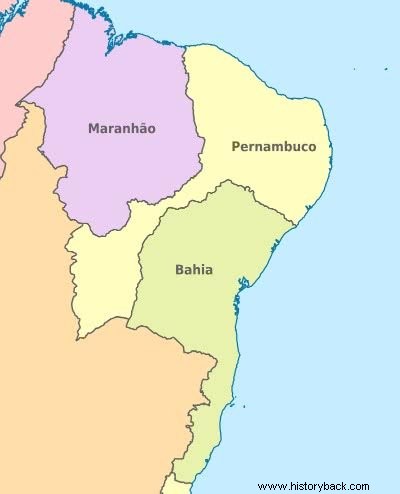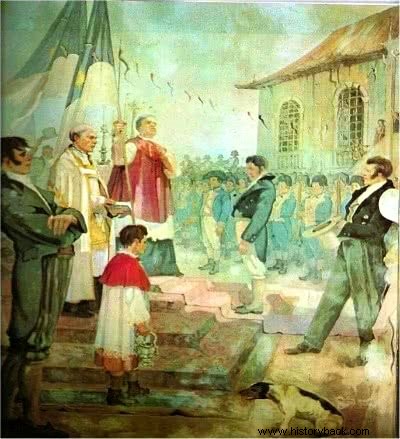The History of Pernambuco it is marked by conflicts between indigenous and Portuguese, Dutch domination and even an attempt at independence.
Discover the history of one of the oldest states in Brazil.
Indigenous people in Pernambuco
The territory in what is now the state of Pernambuco was populated by several indigenous tribes such as Caetés, Cariris and Tabajaras, among other ethnic groups.
Each had its own language and customs and were often enemies with each other. This fact was important for Europeans, as they made alliances with different indigenous peoples in order to conquer the territory.
Colonization of Pernambuco
Through the system of Hereditary Captaincies, Duarte Coelho took possession of the Captaincy of Pernambuco, initially called Captaincy Nova Lusitânia. In 1535 the village of Olinda was founded and in 1537, it became Vila.
Likewise, in 1537, the city of Recife was founded.
Not all the Hereditary Captaincies were successful, but thanks to the cultivation of sugarcane, the Captaincy of Pernambuco prospered.
At first, the Portuguese used indigenous slave labor in sugarcane farming.
However, the planters started to use black enslaved people on the plantations, due to the lucrative slave trade with the Portuguese colonies in Africa.
Pernambuco Territory
The Captaincy of Pernambuco comprised a much larger territory than the current one. It incorporated what we now call the states of Paraíba, Rio Grande do Norte, Alagoas, Ceará and part of Bahia.

Approximate territory of the Captaincy of Pernambuco.
Reef Capture
By the end of the 16th century, the Captaincy of Pernambuco had become one of the richest in the colony. This fact attracted the attention of English, Dutch and French who organized expeditions to take the then capital, Olinda.
It is important to remember that, at this time, Portugal was united with Spain, in the period known as the Iberian Union. In turn, Spain was at war with England and Holland.
So it didn't matter whether to invade Olinda or Seville. The English, allied with the Dutch, took Recife in 1595 and took several valuable products such as sugar, wood and cotton.
From there, the Captaincy organized two companies to defend Recife and Olinda.
Dutch Occupation (1630-1645)
The Dutch invasion began in Bahia in 1624 and they were expelled from the capital thanks to the action of a Portuguese-Spanish fleet a year later.
However, they would return to the charge to conquer a piece of the sugar trade by invading Recife and Olinda, in 1630.
Despite fierce fighting – Olinda was burned – the Dutch settled in those lands until the outbreak of the Pernambuco Insurrection in 1645.
See also :Battle of the Guararapes
War of the Peddlers
The War of the Peddlers took place between 1710 and 1711 between the planters concentrated in Olinda and Portuguese traders who lived in Recife.
Many historians point to this war as the first nativist rebellion in Brazil. After all, the conflict put the white elite already born in Brazil and the Portuguese newcomers from the metropolis on opposite sides.
Cariris Confederation
The Confederation of Cariris or Barbarian War was a series of battles that took place between the years 1683 to 1713.
After the expulsion of the Dutch, Portuguese settlers continued to expand towards the northeastern hinterland. They sought to increase sugar and cotton crops, as well as pasture for cattle.
However, some indigenous tribes, such as the Cariris, Crateús and Cariús, got together and started to attack the farms.
In order to defeat them, the northeastern landowners had to bring in bandeirantes from São Paulo to fight them. The Confederation of Cariris ended only in 1713 when the last pockets of resistance were exterminated in Ceará.
Pernambucan Revolution - 1817
In the first half of the 19th century, several territories on the American continent rebelled against European domination.
In this way, inspired by Enlightenment ideas and the Independence of the United States, a group of insurgents plans the emancipation of the now province of Pernambuco.
Victorious at first, the participants managed to establish a provisional republican government, establish freedom of worship and of the press.
They were harshly repressed by troops sent by Dom João VI. As punishment, four participants were executed and the territory of Alagoas became an independent province.

Blessing of the Flags of the Revolution of 1817, by Antônio Parreiras.
Confederation of Ecuador – 1824
The Confederation of Ecuador was a separatist and republican revolt that took place in Pernambuco in 1824. It must be understood within the context of the First Reign, when Dom Pedro I ruled.
The Emperor had convoked a Constituent Assembly to draft the Magna Carta of the new country. However, dissatisfied with the result, he decides to dissolve it and grants a Constitution with a centralizing tonic.
The Confederation of Ecuador was harshly repressed by the imperial troops attacking Recife and some of its leaders, such as Frei Caneca, were executed.
Praieira Revolution – 1848
The Praieira Revolution was a movement of liberal character. He defended the freedom of the press, the nationalization of the retail trade and the end of the Moderating Power.
The protests began at the headquarters of the newspaper Diário Novo, located on Rua da Praia, and its members were known as "praieiros". The fighting started in Recife, but soon spread to the Zona da Mata of Pernambuco.
The rebellion would only end two years later with the imperial intervention and several of its leaders were amnestied.
Fun facts about Pernambuco
- The first synagogue in the Americas was established in Recife in 1630.
- The flag of the state of Pernambuco is the same used by the insurgents of the 1817 Revolution.
- Olinda was the second Brazilian city declared a World Heritage Site in 1982. The first was Ouro Preto-MG.
